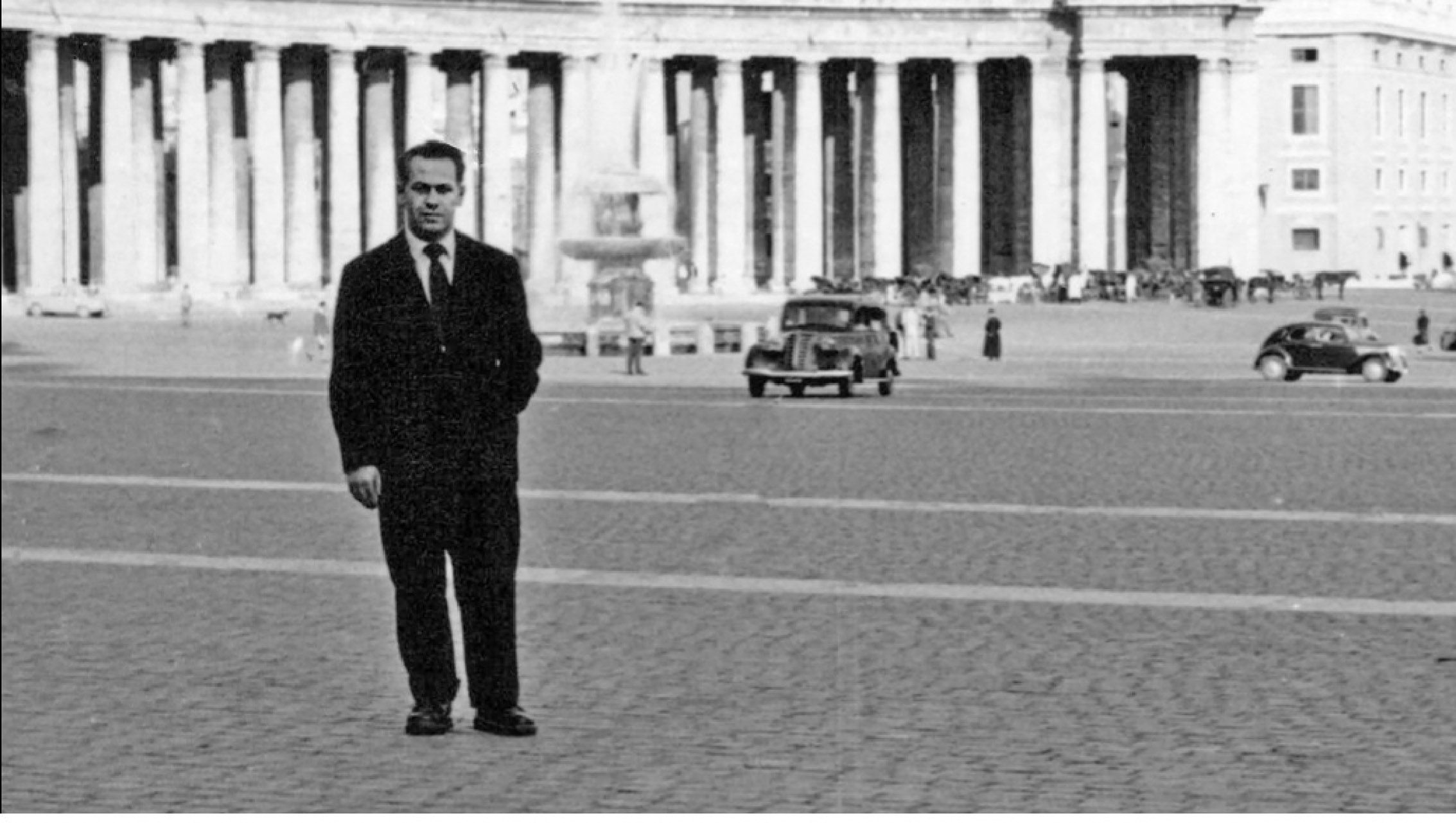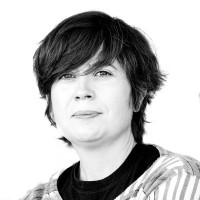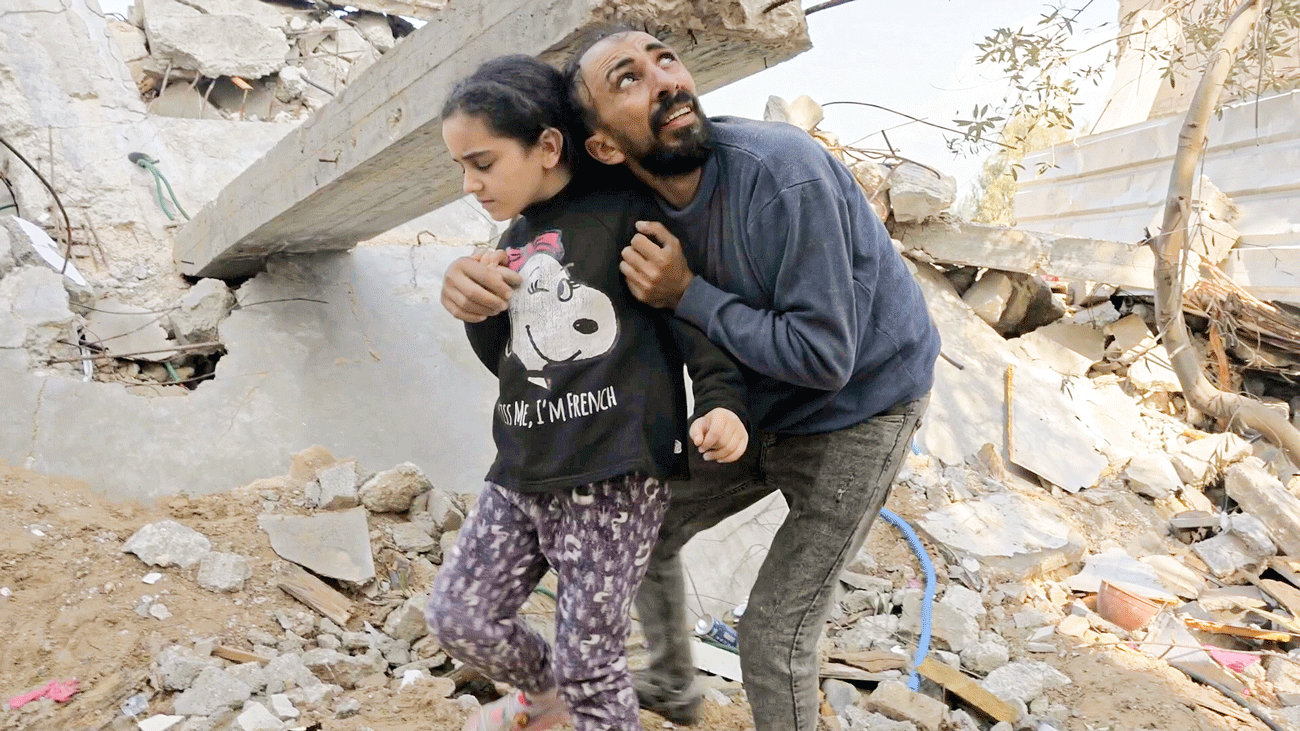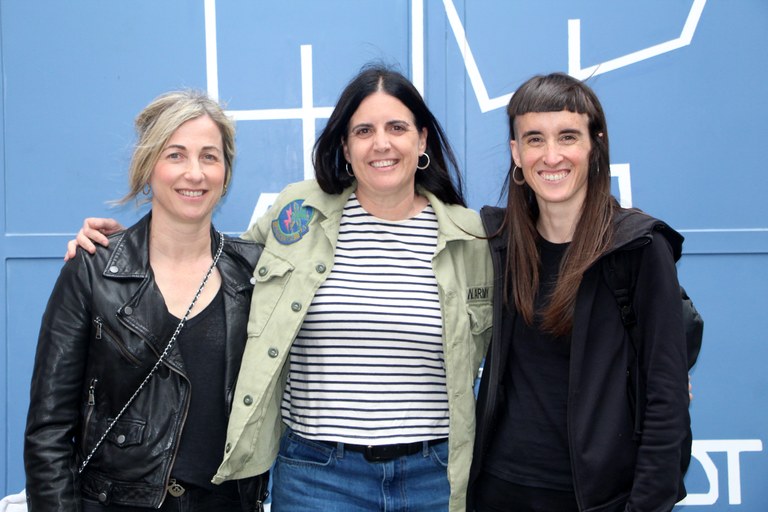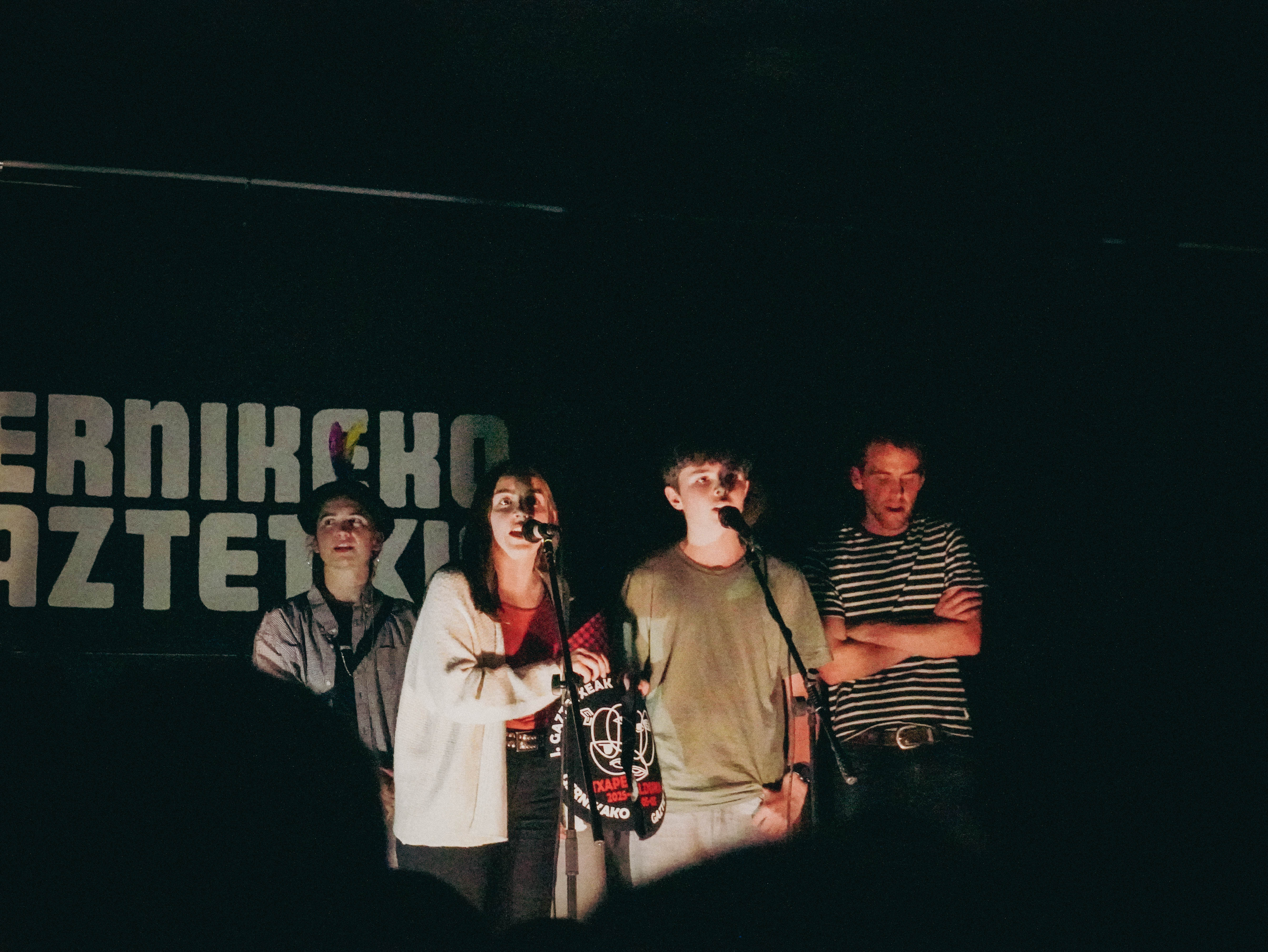"In the tattoo, besides the result, the process is very important"
- Until in a meal I was next to the tattoo artist Tula de la Cabra, in the past Feminist, I didn't know there was the handpoke technique. I immediately confessed that marking my skin has always attracted me and attracted me. We were talking to the desserts. And now I have tattoos.

Cough of the goat. Pasaia, 1993
He studied Fine Arts in Bilbao and about six years ago he started doing tatuajes.Tatuado with the Handpoke technique, that is, by hand, without machines, he likes to watch and pamper the tattoo process. Its characteristic style is to draw lines, other geometric forms, fauna and flora, as well as elements of the Basque imaginary. On your Instagram you will find a beautiful sample: Tos @cabra.
When and how did he start making tattoos?
Towards 2017. Living in Bilbao, I started jumping with a friend and on the covers of my friends. The truth is, I never projected that I would be a tattoo artist, we started by the game and the trajectory of these years has been quite improvised. Then I went back to Gipuzkoa, and he found out that he was tattooing people, besides the handpoke technique, quite unknown, and they started coming to me. Gradually I've been tattooing more and more people.
Even though you didn't project yourself in that job, did you like tattoos?
Yes. The first one I did very soon, my aunt and my mother helped me. Since I was young, I've had a great interest in the ancient civilizations that used tattooing as a training process.
Use the Handpoke technique. What is it?
I always compare it to hand or machine sewing. In this case, with the handpoke technique, with a needle, instead of using the thread, the ink is the one tracing the line and the support is the skin instead of the fabric.
Were you interested in this technique from the start?
Student precariousness was the cause of not buying the machine. To test it, we bought needles and started with that. The machine was much more expensive, it required some knowledge. We must also learn how to puncture with the handpoke technique, but I think it is closer, more crude.
However, at one point he bought a machine and then stopped using it.
I bought and made some tattoos, especially because people asked me big things, and the machine is faster and more practical. But I didn't have the same feeling I had with the handpoke. I feel much more connected to the handpoke technique: no sound, just needle, skin and me; that purity.
.jpg)
What are the main differences between the two techniques?For me
handpoke is something energetic, I think closer to the skin or to the other person. Healing is faster with the handpoke technique, the skin suffers less and bleeds less… But that also depends on the person’s life.
Also, with Handpoke, you don't need electricity, you have more freedom of movement.
Yes, it offers more possibilities of movement, tattooing in other spaces, tattooing in nature, guaranteeing, of course, hygiene measures. And I love tattooing in nature, I love tattooing in spaces where there are megalithic prints.
What is your interest in this?
It is said that the megalithic constructions rose where there were great flows of energy, where there were underlying waters, and the feeling that somehow there has been produced in those spaces places makes special emphasis on the process. I do not know if I mentioned it, but for me, in addition to the result, the process is very important.
"I feel much more connected to the handpoke technique: no sound, just needle, skin, and me; that purity"
Where does the name Tos de la Cabra come from?
From the saying. The truth is, I don't remember very well. It was at the time of Bilbao thinking about the name of Instagram. I'm riding through my mountaineering and being Mrs. Suziri. Moreover, the goat’s cough also reflects this aspect of the process: invisibility is important.
It has a tattoo style: plants, geometric shapes…
I would say that there is something that attracts me to geometry in different fields: sculpture, architecture and drawing. The elements of nature and the utensils of the Basque imaginary have also been forms that have left me from within.
And the lines?
I remember when I started making lines they said to me in the village: Why? From the first moment I have enjoyed this process of seeing the body in a whole and playing with él.Ver what that body asks me and organize it with lines.
How is the relationship with the person to be tattooed? Is there any collaboration? You have some designs… One of
my challenges is to do more designs, because I have done them, but less than I wanted, because in the end I have been covering the needs of everyday life. Ask for something, do this.
So people ask you to want to do this or another -- Yes, I've also given negative if you ask me
for shapes or elements that don't attract me, and I've also denied people that haven't given me a good feeling or that haven't made me feel safe. They usually write me from Instagram or word to mouth: send or call a message. Hence the process. Say what your idea is, I imagine it in my style, and I try to be as close as possible and feel comfortable. It can also be improvising.
What do people ask you most?
Well, in relation to the previous question, lines, geometric elements, shapes and symbols from here and from other cultures. Ornamental objects. If at the end there are ornamental stripes, they play with the shape of the body, adapting to the shape of the ears, fingers, feet...
Any experience you have kept in your heart?
Special relationships with people in general. I have created nice relationships through the tattoo, I have met many interesting people, I have tattooed the people I admire, a very special energy is generated in the process... Tattooing in other places.
Do you create or create a specific tattoo environment?
I would say I have some rituals. On the one hand and in my life what is usually very important, the smell. Incense and other odours. Then also the music, I choose the playlist according to what I feel at the moment, or I don't know, they're prejudices, but if I tattoo you, Danele, I'll put this playlist. And then the clothing, always in black. On the other hand, when I have tattooed in nature, many times that exchange has occurred, to know new spaces. The other day I went to Oiartzun and I was taught a place I didn't know, with purple orchards, and it was very nice to tattoo it.
As I said, besides tattooing in his space, he does it outside of him.
It's not something I do many times, but yes. This year, for example, I was on a Greek island during the summer. I took needles and it was the experience of Christ.
Did you have tattoos in Greece?
Yes. I put a little cartoon in the village and a lot of people wrote me. I didn’t imagine it and… It was a very special experience. Abroad, I've never been making such a special relationship. Greece has a very strong culture, closely linked to the earth and its history, and in such a process it has been special, I think it is another way of being part of a space and of creating relationships.
"I've also tattooed very old people; an 80-year-old woman I made the first one. He, his daughter and his nephew came to make the same tattoo.”
They say that once started, tattoos are like an addiction… Do you think so? What does tattoo symbolize? This depends on everyone's connection
to their body and what they want to represent with that tattoo. Some tattooed the name of their children or someone else, or a stone of their dwelling -- anything. For me, what creates addiction is the process, what gives me the process, but there's a concept of body transformation, that people also do through piercing, dress, hairstyle change... I think that's a certain addictive, that's what engulfs it, and besides following the fashions, of course. Some have very clear intentions: they want to have the whole arm tattooed, or the whole body, or to tell a story on the back, or to tattoo only the elements of Japan… Others, in my case, do the instant. I can't imagine what I want in two years' time. Now I'm here and I decide to do this, but in the future who knows.
The moment of tattooing can also have a cathartic point, the intervention is very direct in the body, it causes many sensations, pain and
pleasure… It also includes tolerance and the relationship of each person with pain. Some prefer more pain but less time; I don't recommend handpoke to them, or yes, but keep in mind that it will be longer than with the machine. The time that doesn't matter to others. They enter a kind of trance, enjoying in some way the process: “I’m making a tattoo, time X, I don’t know when it will end, but go ahead.”
She has also participated in Tatoo Circus and Feminist. What was that like? It was
another experience and I am very grateful. Although I've enjoyed it, I prefer to tattoo myself in a more intimate and quiet way. You enter the festivals as quickly as you can come, put the muzzle, do and goodbye. One after the other. I always have the pain of not pampering and taking care of every process.
It has a more militant point.
Tattoo Circusa is a day against prisons to make the fight against prisons visible and funded. I was once in the Errekaleor circus. To some extent it's militant, even if you don't get any money for the ducks, you get a lot of it, because of that I've expanded my work and I've met other artists. I was at another such festival in Estella, a Tattoo Circus of women and trans, where I met very interesting artists like trans, bolleras, women…
Because it's also dedicated to Boller activism. Does it affect your activity?
I think that has opened more doors for me. We've always talked to friends that if we met doctors, gynecologists, massage therapists -- tranfeminists or baskets -- we would go there to get that safe space. And I think with that logic, too, a lot of transmarivibollo people come to me. In addition, there will be other artists who, due to lack of affinity or aesthetic taste, opt for another.
Have you met other tattoo artists of similar positioning?
Yes, those in the area of Barcelona, the basins, the transas, those who walk a lot in that militant world of tattoos, and especially those who work with people from the collective. It was very interesting to share experiences and get to know different realities.
.jpg)
Is it hard to survive as a tattooer?I have tried to
have other sources of income, fearing not to lose that passion or lose that passion. When the tattoo has gained more weight in my economic needs, I have felt that it has lost some of that essence. I have had and still have contradictions in that hobby trade. For me, the tattoo is something like going up and down to the top, it gives me pleasure, a kind of ascent ...
And he doesn't want that boom to become his primary source of income, because his relationship with tattooing would change because of money.
Totally. However, I find it difficult. Having multiple sources of income takes time and energy, and that ultimately makes my life in a hurry and doesn't take care of other things.
Do you have dreams or challenges for the future?
Last week, I dreamed of tattooing myself on a tattoo studio called Aizkora. This study exists, it is in Calle Nabarreria, in Pamplona, but in my dream the workers of it were transmarivollas people and we tattooed especially people from this group. A model of working militancy of this kind does appeal to me and, for example, I think that if my work becomes a normal job, I would choose that path and I would like.
There's bias about tattoos. Have you received it when you say you're a tattoo artist?
In the family, at first, I was told: “How have you started tattooing? Do people make tattoos?" Not just because I had tattoos on my body, but because I started making others. In the family they had a lot to do with the jail or the sailors, and one day his daughter made tattoos… “There was no shortage.” Hence the reaction.
Now you don't see it that way?
No, now you're interested. Their vision has also changed. In general it has also changed. I've also tattooed very grown-up people; for example, an 80-year-old woman had her first tattoo.
Look.
He, his daughter and his nephew came to make the same tattoo. It was very nice.
BRN + Neighborhood and Sain Mountain + Odei + Monsieur le crepe and Muxker
What: The harvest party.
When: May 2nd.
In which: In the Bilborock Room.
---------------------------------------------------------
The seeds sown need water, light and time to germinate. Nature has... [+]
Euskadi markak, eraikuntza sektoreko ekonomiaren estrategian, “industrializazioa” mantrarako hitz gisa hartu duela jakinarazi berri du Eusko Jaurlaritzak. Etxebizitza publikoaren eraikuntzan industrializaturiko prozesu eta elementuak lan guztien %65a izatea... [+]
Last week, during the blackout, seeing ourselves vulnerable, we began to investigate many people in order to understand what happened: how does the infrastructure that transports electricity work? Why is it getting old? I am fascinated by the physical phenomenon of electricity... [+]
Aurreko tertuliako galderari erantzuteko beste modu bat izan zitekeen, akaso modu inplizituago batean, bigarren solasaldi honetako izenburua. Figura literarioaz gaindi, pertsonaia zalantzan jartzeko, edo, kontrara, pertsonaiaren testuingurua ulertzeko saiakera bat. Santi... [+]
Now that everyone has become more Franciscan than the Pope, it’s worth remembering our unsurpassed classics. There was one in the 17th century, his grace was Arnaut Oienart. And since we can’t immerse ourselves in all his works, today we will praise O.ten youth in... [+]
“We rehearsed, we showed it to the boys, we were there when they needed help for the grill, but then we never danced in the square or even crossed our mind.” Oihane Auzmendi Iturbe (Legazpiia, 1977) is a dancer of the dance group Roots, but for years he did not have the... [+]
Amartuvshin Enkhbat baritonoa
Pianoan: Stefano Salvatori.
Antolatzailea: OLBE.
Zer: Verdi, Mascagni, Leoncavallo eta Giordanoren operen ariak.
Non: Bilboko Euskalduna Jauregian.
Noiz: martxoaren 29an.
Martin Martina and the Mystery of the Golden Comb
by Amancay
Gaztelañaga Batu, 2024
-----------------------------------------------------
Amancay Castañaga launches the mystery of Martín Martina and the golden comb accompanied by the illustrations of Alain Martínez... [+]
The annoying noise of the works of the neighbors has awakened me even today. I put my head on the pillow, and I tried to sleep for another twenty minutes, but there was no one to shut that drill down. I woke up and looked at the table of duties that I did at the beginning of... [+]









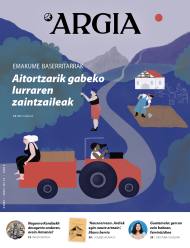


.jpg)
